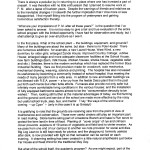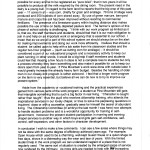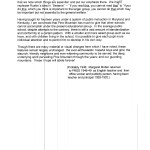Pine Mountain Settlement School
Series 09: BIOGRAPHY – Staff/Personnel
Margaret Motter Interview/Reflections [4 pages]
MARGARET MOTTER c. 1946 Reflections
Miss Motter was asked to reflect on the changes she notices in the physical facilities, staff, and programs at Pine Mountain. Her first-hand knowledge of the School, formed when she came as a young woman in 1928 and when she returned to work at Pine Mountain from 1946 to 1949, encompasses a span of more than twenty years of critical shifts in personnel and purpose in the School. She is a particularly astute observer.
This interview was printed in the November 1946 issue of Notes from the Pine Mountain Settlement School, vol. XX, no. 1, pages 1-3.
Click here to read Marguerite Butler’s biography.
TAGS: return to the School after 14 years’ lapse ; changes in buildings, facilities and vehicles ; new and continued conservation efforts ; changes in school organization ; end of formal grading ; increased attention to vocational training ; usefulness of sound movies ; preservation of cultural background ; retention of social programs ; students no longer separated by age ; shorter work program ; farm developments ; Citizenship Committee ; chapel services ; deterioration of Open House and Infirmary ; comparisons to average public school ; the spirit of Pine Mountain remains unchanged ;
GALLERY
- Margaret Motter, “Reflections” Page 1. motter_D2_02001.jpg
- Margaret Motter, “Reflections” Page 2. motter_D2_02002.jpg
- Margaret Motter, “Reflections” Page 3. motter_D2_02003.jpg
- Margaret Motter, “Reflections” Page 4. motter_D2_02004.jpg
TRANSCRIPTION
[page 1]
There is always a peculiar joy in returning to a place where one has invested a part of oneself. It was therefore with no little enthusiasm that I planned to resume work at P. M.[Pine Mountain Settlement School] after a lapse of fourteen years. Despite the warnings of friends and relatives as to the inevitable changes I’d note with the further implication that I’d be more or less disappointed, I find myself fitting into the program of yester years and gaining tremendous satisfaction thereby.
“What are your impressions of P. M. [Pine Mountain Settlement School] after all these years?” is the question that I’ve been asked to answer. It is not too easy to give a fair and true evaluation of the entire school program with the limited opportunity I have had for observation and study; but I shall attempt to give an over-all picture as I see it.
In the first place, What of the school plant – the buildings, equipment, and grounds? Many of the buildings are about the same, but alas – there is no Pole House! There are numerous additions: for example, a new Laurel House, West Wind, a new dormitory for older girls; enlarged Zande House; improved Country Cottage; Jubilee House; enlarged stage and more adequate classroom facilities at the School House; new farm buildings (Barn, milk house, chicken houses, smoke house, vegetable cellar and silo.) Besides, there is the modern workshop which has replaced the former Boys Industrial Building. Here we find provision made for woodwork, auto mechanics, mechanical drawing, weaving, science and printing. The hospital has also increased its usefulness by becoming a community instead of school hospital, thus meeting the needs of many persons from a wide area. In addition to new and better buildings we are blessed with R.E A. power — a far cry from the feeble Delco plant that in the past put forth such heroic but often futile efforts. Furnaces also provide not only safer but stable living conditions in the various houses; and the installation of fully equipped bathrooms seems almost to be the “consummation devoutly to be wished.” Then, looking still further at the material advantages of today, we find farming and the genera! work and service of the school are made more effective by the noisy but useful school truck, jeep, bus, and tractor. Truly “the ways of the world are a-coming — up Cyarr” (only in this case it is up Greasy!)
It is gratifying to note that the grounds are receiving care from the point of view of conservation. Those ever-useful cinders still play an important part in maintenance and in road making. Stone banks along part of Limestone Branch and Isaac’s Run serve to protect the farm land in time of flood. Planting of “cover crops” of rye and crimson clover prevents exposure of 19 acres of vegetable and field land to winter erosion.
As we pass from one end of the campus to another we note provision for social activities. Big Log Lean-to is still kept ready for picnics; and the playground, formerly useless after dark, is now provided with light so that recreation can be carried on each evening. A charming setting has been created in a little natural amphitheatre [Dancing Green just below Far House and West Wind for the traditional May Day.
But what of the school itself, the academic program? As one might expect, part of the
[page 2]
school program (assemblies and some class work) continues along lines similar to work of former years; but the organization of the school has greatly changed. There seems to be more purposeful planning of curricular offerings and a wise follow-up of counseling. The curriculum for the second year is a very valuable addition to school work, giving experience and training in consumer education, buying and selling, book-keeping, and other features of a cooperative program. Besides, the management of the small school store gives pupils an excellent opportunity to put into practice some of the information gained from classroom study and discussion.
Another change is the departure from traditionally formal grading. For some years P. M. [Pine Mountain Settlement School] has given no grades or credits; instead, the instructor evaluates the pupil from various angles (attitudes, efforts, and actual results) and the pupil likewise evaluates himself by writing a letter to his parents at stated times.
I find that vocational training is being given more attention and it becomes a happy balance both for the especially studious pupils and those who prefer working with their hands. Educational movies once a week and other movies about once a month are also a very helpful addition to the school program. In contrast to the days when the use of electricity was so limited, the sound movies give our pupils a wonderful opportunity for visual education. “Pride and Prejudice,” “A Message to Garcia,” and “My Friend Flicka” open up new worlds and interests. The fact that the school is accredited and is given “A” rating by the state Department of Education speaks for itself regarding the standard of work being done.
I have learned with regret that most of the old ballad singers are gone and that some of the “fotched-on” music has replaced much of the native musical heritage. It is good to see that P.M. still tries to encourage the preservation of the cultural background of the mountains; and the pleasure of pupils in the singing and dancing is ample proof of the wisdom of retaining some of the old customs. I am also happy to know that the School still features the “special days” – Fair Day, Mountain Day, Thanksgiving, Christmas Week, Easter, and May Day, as well as other parts of the social program.
As I have observed conditions during these first months of school, I have been deeply impressed with the work program. When I was at P. M. there was a definite separation of pupils in the grades and those in high school which I greatly deplored. I could see that it helped the work program by having the older group work most of the morning while the grades were in school and reverse the procedure in the afternoon. I pled for at least a portion of the day when all pupils could be in school at the same time for I realized there was need for a feeling of oneness on the part of the student body. During my last year we were taking the first steps in this direction by having a short daily assembly and a class period when all pupils were in school together. I now find that the work program has been so shortened that all work or go to school at the same time. Perhaps the various tasks may not be done quite so thoroughly as in former years when there was more time, but in many respects it seems to me that satisfactory work is being done.
As P. M. consists of so much more than an academic school, being instead a settlement. I consider the work program as it fits into the entire set-up of basic importance. Two of our former students, now on the staff, evince a very cooperative spirit as they render service in their respective fields. I have talked with both of them and can see they serve so well because they believe in the School and appreciate what it has done for them. I asked the farmer [William Hayes] to give me a few facts
[page 3]
regarding some of the developments I had noted and the following excerpts from his report are worth noting. He states that the herd [Ayrshire herd] is in good condition, that it is now possible for every animal to be registered as “pure bred”; that in two years it will be possible to produce all the milk required by the dining room. The present need in the dairy is a young bull.
In regard to the farm land he reports that the big crop of this past year — 11 acres in all — was corn, chiefly for grain and ensilage. 70 tons of silage were produced and 250 bushels of corn stored away. By use of green manure, barnyard manure and crops the soil has been improved without resorting to commercial fertilizers. The presence of a limestone quarry within hauling distance also makes possible the use of lime on badly depleted pasture land. The farmer’s opinion of this phase of school activity is challenging:
“I think with our work program as limited as it is, that we, the staff members and students, should feel that it is our main obligation to join in and help on an important work or emergency that is essential to our school. I mean that as we are all a part of this school system we should always be on the alert for making improvements and doing our work more efficiently. I believe that should a student be called upon to help with a job aside from his classroom studies and the regular two-hour program — (such as cutting corn for ensilage) — it should be considered a part of our educational program and a necessary activity to keep our plant running; in other words, it would be a big help if staff members and students could feel that missing a few hours in class is not a complete loss to students but only a process whereby they learn something and also make it possible for us to keep our doors open from year to year. If Pine Mountain’s work were done with outside labor it would greatly increase the already heavy farm budget. Besides the handling of older men in our closely-knit program is rather awkward. I feel that a longer work-program on the farm is very essential, but believe all we can do now is to try to improve our present system.”
Aside from the academic or vocational training and the practical experiences gained from various parts of the work program, a student at Pine Mountain still gets that intangible something that is such a big factor in real living. “Character is caught rather than taught”: thus the pupil who receives citizenship training, who attends the inspirational services in our lovely chapel, or tries to solve his perplexing questions in Inquirers’ class or with a counselor, gradually sees for himself the secret of abundant living.
The Citizenship Committee (in embryo the last month I was here) now attempts to handle student problems and is a wonderful opportunity for training in self-government; moreover the present student participation in morning and evening chapel services is another way in which joys and girls gain self-confidence, self-control, self-expression, and other factors in character development.
In conclusion I wish to make a few comments. I can see a few areas where things may not be done with the same degree of efficiency achieved years ago. For example Open House which used to be a charming, well-kept Guest House or a quiet refuge on free days, shows in a distressing way the wear and tear of years. With the limited student help in the work program we can understand neglect of a place that is not regularly used. The same sort of situation is created by the enlarged scope of service now rendered by the Infirmary. As more girls are needed to help with this increasing
[page 4]
usefulness, fewer girls are available in the various houses for cleaning, ironing, and help in the kitchen. Here again we have to see, as our farmer has already suggested, that we note which things are essential and put our emphasis there. We might rephrase Ruskin’s idea in “Sesame” — “If you read this, which you think is important to the larger group, you cannot do that which may be important but not essential to the general welfare.”
Having taught for fourteen years under a system of public instruction in Maryland and Kentucky, I am convinced that Pine Mountain has much to give that other schools cannot accomplish under the preset educational set-up. In the average public school, despite attempts to the contrary, there is still a vast amount of standardization and conformity to a certain pattern. With a smaller and more select group such as we have, and with children living in the school, it is possible to give each pupil more individual attention and to permit him to develop in his own way.
Though there are many material or visual changes here which I have noted, these features remain largely unchanged: the ever-enthusiastic, hopeful boys and girls: the staunch, friendly neighbors and ever-widening community to be served; the deep, underlying spirit pervading Pine Mountain through the years; and our guarding mountains. These I hope will abide forever!
(This essay was probably written in 1946. Margaret Motter returned to work at PMSS 1946-1949 as English teacher and then office worker and publicity person. She had been a teacher and principal from 1928 to 1932.)





